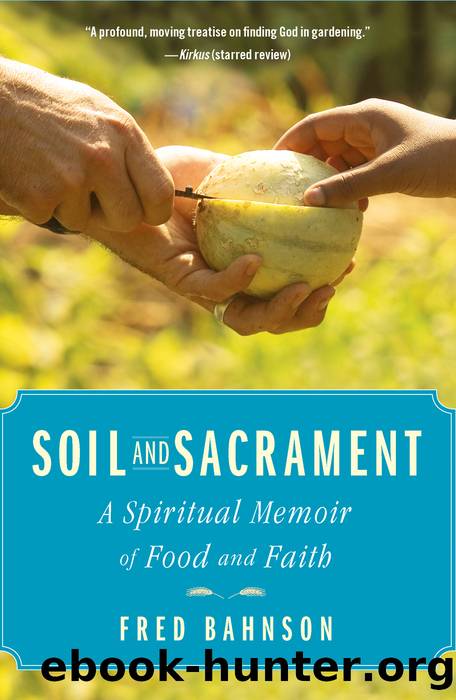Soil and Sacrament by Fred Bahnson

Author:Fred Bahnson
Language: eng
Format: epub
Publisher: Simon & Schuster
CHAPTER SIX
Significant Soil
For most of us, this is the aim
Never here to be realized;
Who are only undefeated
Because we have gone on trying;
We, content at the last
If our temporal reversion nourish
The life of significant soil.
âT. S. Eliot, The Dry Salvages
In September of 2005, my first year at Anathoth, I called up a local farmer named Vaughn to see if I could buy chicken manure for the garden. I had never met Vaughn, but knew that he was a former member of Cedar Grove UMC. Vaughn told me they used all their manure on their tobacco fields. I thanked him anyway and was about to hang up when he said, âBut even if I did have some, I wouldnât sell you any.â Vaughn proceeded to berate me, an outsider, for coming into his community, âwhere my family has been since 1783,â and âmessing everything up.â He said he thought the community garden was a terrible idea, that âoutsidersâ had taken over the church, and that as long as âyou outsidersâ were doing things like starting community gardens, heâd never set foot in the church again. I asked if we could talk about this in person. Why was the community garden such a bad idea? He laughed bitterly and hung up.
I was determined not to let naysayers like Vaughn deter my enthusiasm. Good things were also unfoldingâa well digger put in a well for half price, a crew of carpenters volunteered to build the barn. Yet even as the garden project grew and won trust in the community, a small but vocal opposition persisted. Some church members, in all four years I served at Anathoth, refused to set foot on the place.
It certainly didnât help that I was a cultural outsider who practiced new methods of agriculture. âOrganicâ in this tobacco-growing county was a four-letter word. But despite my strong convictions about growing food organically, I tried to reach out to the older farmers in the congregation who farmed with conventional methods.
Mr. Rimmer lived across Mill Creek Road and was Anathothâs nearest neighbor. He wore coveralls every day except Sunday and alternated caps given to him by the Farmersâ Credit Union, Brownâs Feed & Supply, and John Deere. Sometimes I walked across the road to borrow a hank of rope or to ask his advice about planting dates (âyou plant your peas on Ash Wednesdayâ). Other times he would drive up in his beat-up Chevy pickup to see what kind of strange things we owgaanic people were planting that day. Several years into the project we built a brick-fired pizza oven. Mr. Rimmer soon stopped by wanting to see our new âpizza hut.â Heâd farmed this land all his life, tobacco mostly, and as a result of much time spent around carburetors and corn pickers had lost the ends of several fingers on each hand. When he talked he massaged his stumps, as if he could feel those parts of himself he once possessed.
One day Mr. Rimmer donated a bushel basket of turnips. âGive these to your people,â he said.
Download
This site does not store any files on its server. We only index and link to content provided by other sites. Please contact the content providers to delete copyright contents if any and email us, we'll remove relevant links or contents immediately.
Hit Refresh by Satya Nadella(8345)
When Breath Becomes Air by Paul Kalanithi(7273)
The Girl Without a Voice by Casey Watson(7271)
Do No Harm Stories of Life, Death and Brain Surgery by Henry Marsh(6343)
A Court of Wings and Ruin by Sarah J. Maas(6115)
Hunger by Roxane Gay(4235)
Shoe Dog by Phil Knight(4183)
Everything Happens for a Reason by Kate Bowler(4076)
A Higher Loyalty: Truth, Lies, and Leadership by James Comey(4041)
The Rules Do Not Apply by Ariel Levy(3914)
Tuesdays with Morrie by Mitch Albom(3841)
The Immortal Life of Henrietta Lacks by Rebecca Skloot(3833)
How to Change Your Mind by Michael Pollan(3689)
Millionaire: The Philanderer, Gambler, and Duelist Who Invented Modern Finance by Janet Gleeson(3576)
All Creatures Great and Small by James Herriot(3527)
Elon Musk by Ashlee Vance(3461)
Tokyo Vice: An American Reporter on the Police Beat in Japan by Jake Adelstein(3441)
Man and His Symbols by Carl Gustav Jung(3326)
The Money Culture by Michael Lewis(3291)
